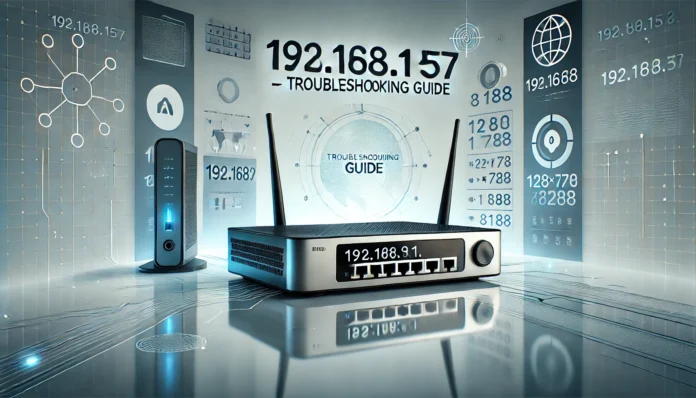When you see “192.168.1.257:8188,” it probably looks like an IP address with a port number added at the end (the 8188 part). But there’s a catch here.
An IP address should follow strict rules, and 192.168.1.257 doesn’t meet those rules.
In technical terms, each section of an IP address, separated by dots, should range from 0 to 255. The 257 in 192.168.1.257 makes this address invalid.
Why Does This Matter?
If you’re working with a network device, you’ll need valid IPs to ensure smooth operation. Invalid addresses like 192.168.1.257 simply won’t connect.
To keep things running, stay within the valid range, using something like 192.168.1.2 to 192.168.1.254.
The Role of Port 8188: How Does It Fit In?
Let’s talk about 8188 – the “door” this IP address is trying to access. Each port is an entry point for specific network services or applications on your device.
For example:
- Port 80 is standard for web browsing.
- Port 443 is secure browsing.
- 8188 could be used for a custom app or a specific network service.
So, while 8188 might work for specialized purposes, pairing it with 192.168.1.257 won’t lead anywhere unless the IP is valid.
Real-Life Example: Setting Up Your Network
Imagine setting up a network at home, connecting everything from your laptop to a smart fridge. The router usually assigns addresses within the 192.168.x.x range for each device, keeping your local connections organized.
Let’s break it down simply:
- Router’s Address: Often set to 192.168.1.1. Consider it the central hub for your network.
- Device Addresses: Devices get assigned IPs like 192.168.1.2 for a laptop, 192.168.1.3 for a phone, and so on.
If you try setting up 192.168.1.257:8188, the 257 part will stop things. Stick to valid IPs to ensure smooth connections.
- Also Read: Cute:2qhgr-ilhj8= Pikachu
Common Questions About 192.168.1.257:8188
1. Why won’t 192.168.1.257 work as an IP?
- Answer: 192.168.1.257 doesn’t fit the format required for IPs. Each number (between dots) should be between 0 and 255.
2. What’s the purpose of Port 8188?
- Answer: Ports guide traffic to specific services. 8188 could be used for unique applications but won’t be effective unless paired with a valid IP.
3. How can I find my router’s IP if 192.168.1.257 isn’t correct?
- Answer: Look for the default gateway in your device’s network settings. Most routers use 192.168.1.1 or 192.168.0.1.
4. Are private IPs, like those in the 192.168 range, safe?
- Answer: Private IPs only work within your local network, so they’re safer from outside access. Securing your Wi-Fi and router makes them even safer.
Setting Up Valid IPs for Smooth Connections
To keep things simple and working correctly, follow these tips for your network setup:
- Use DHCP: Your router’s DHCP function automatically assigns valid IPs. This means it’ll pick addresses like 192.168.1.10 instead of something invalid like 192.168.1.257.
- Double-Check: If you’re manually setting IPs, stay within the range of 192.168.1.2 to 192.168.1.254.
- Set Static IPs Mindfully: Devices needing the same IP, like a printer or a camera, can benefit from static IPs in the valid range.
Private IP Addresses: Why 192.168.x.x?
Private IP ranges, like 192.168.x.x, are explicitly designed for local networks. This keeps your network devices connected internally without exposing them to the internet.
For example:
- 192.168.1.x is a common range for home routers.
- Some routers may use 192.168.0.x as an alternative.
These addresses allow you to connect devices but shield them from direct outside access.
If you’re new to networking, this can sound tricky. But just remember:
- Use 192.168.1.x addresses.
- Keep each device’s IP unique.
- Never go above 255 in any section of an IP.
Troubleshooting Tips: Avoiding Common IP Issues
Using 192.168.1.257 might seem like a simple error, but can lead to frustration. Here are a few quick troubleshooting tips if your devices aren’t connecting:
- Verify the IP Range: Keep IPs between 192.168.1.2 and 192.168.1.254 to stay valid.
- Check Your Port: Only use ports that your application needs explicitly. Ports like 8188 are fine if you know they’re required, but they won’t help with invalid IPs.
- Restart Your Router: This can clear up many issues by resetting the DHCP assignments and getting all devices back on track.
Wrapping Up on 192.168.1.257:8188
In short, 192.168.1.257:8188 may look like a straightforward address, but the 257 part makes it a no-go for most devices. Stick to the basics:
- Use 192.168.1.x addresses.
- Pair them with valid ports, like 8188, only if needed.
- Keep each device within the right range, avoiding most IP-related issues.
For a smoother setup, rely on valid IPs, follow your router’s DHCP assignments, and keep each address unique. It’ll save you time and make your home network run much smoother!

